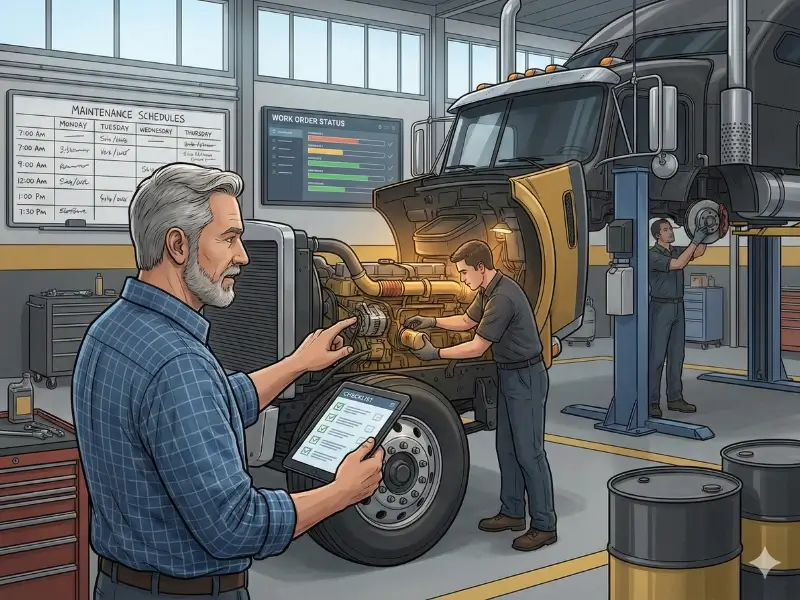Key Takeaways
Fleet management is a critical aspect of any organization that relies on a collection of vehicles for its operations. Whether running a delivery service, a transportation company, or even a construction business, keeping your fleet in top condition ensures efficiency, safety, and cost-effectiveness. One essential tool in the world of fleet maintenance is the fleet maintenance work order. This comprehensive guide will discuss everything you need to know about fleet maintenance work orders, from their types how to create them, and the overall workflow.
What is a Fleet Maintenance Work Order?
A fleet maintenance work order is a documented request or directive that outlines the details of a specific maintenance task or repair needed for a vehicle within a fleet. It is a formal communication tool between fleet managers, technicians, and maintenance staff. Work orders are essential for organizing, tracking, and prioritizing maintenance tasks to ensure that vehicles remain in optimal working condition.
Why Are Fleet Maintenance Work Orders Important?
Fleet maintenance work orders are crucial for several reasons:
- Organization: They provide a structured way to manage and track maintenance tasks for multiple vehicles in a fleet.
- Efficiency: Work orders help streamline maintenance, completing tasks promptly and efficiently.
- Cost Control: By specifying the scope of work and estimating costs, work orders enable better budgeting and cost control.
- Safety: As facilitated by work orders, regular maintenance helps prevent accidents and breakdowns caused by mechanical failures.
- Compliance: For industries with regulatory requirements, maintaining detailed records of maintenance work is essential.
- Asset Lifespan: Properly maintained vehicles have a longer lifespan, reducing the need for frequent replacements.
-
Benefits of Using Fleet Maintenance Work Orders
Using fleet maintenance work orders offers numerous advantages, including:
- Improved Vehicle Performance: Regular maintenance outlined in work orders keeps vehicles operating at their best, reducing downtime.
- Cost Savings: Preventive maintenance identified in work orders helps avoid costly breakdowns and repairs.
- Enhanced Safety: Well-maintained vehicles are safer to operate, reducing the risk of accidents and injuries.
- Compliance Management: Work orders help maintain compliance with industry regulations and standards.
- Documentation: Work orders record all maintenance activities, providing a valuable history of each vehicle's maintenance.
- Resource Allocation: Fleet managers can allocate resources more effectively by prioritizing tasks based on work order information.
Now that we understand the importance of fleet maintenance work orders let's explore the different types of work orders commonly used in fleet management.
Types of Fleet Maintenance Work Orders
Fleet maintenance work orders can be categorized into three main types:
- Preventive Maintenance Work Orders
Preventive maintenance work orders are proactive and involve routine inspections, servicing, and repairs that aim to prevent potential issues before they occur. These orders are scheduled based on time intervals, mileage, or engine hours. Preventive maintenance helps extend the life of vehicles and reduces the risk of unexpected breakdowns. Typical tasks include oil changes, tire rotations, and brake inspections.
- Corrective Maintenance Work Orders
Corrective maintenance work orders are created in response to a specific problem or malfunction identified during routine inspections, driver reports, or diagnostic tests. These orders outline the necessary repairs or actions to address the issue and restore the vehicle to working condition. Corrective maintenance work orders are essential for addressing unforeseen breakdowns and ensuring vehicle reliability.
- Emergency Maintenance Work Orders
Emergency maintenance orders are created for critical situations requiring immediate repairs to address safety concerns or prevent severe damage. These orders take precedence over all other work orders. They are typically reserved for situations where a vehicle is unsafe to operate. Emergency work orders are essential for rapid response to urgent issues like brake failures or engine overheating.
Now that we've covered the different types of work orders let's explore how to create a fleet maintenance work order effectively.
How to Create a Fleet Maintenance Work Order
Creating a fleet maintenance work order involves several key steps to ensure the information is comprehensive and actionable. Here's what you need to include:
Vehicle Information
- Make, Model, Year: Identify the vehicle's make, model, and manufacturing year to ensure clarity and accuracy.
- VIN (Vehicle Identification Number): Include the VIN, a unique identifier for the vehicle, for precise identification.
- Mileage: Note the vehicle's current mileage, often used to determine when preventive maintenance is due.
Work Requested
Clearly explain the issue or maintenance task, providing as much information as possible to help the technician understand the scope of work.
Priority Level
Assign a priority level to the work order to indicate its urgency and importance. This helps technicians and managers prioritize tasks effectively.
Due Date
Specify the deadline by which the work needs to be completed. This ensures that tasks are scheduled and executed promptly.
Estimated Cost
Provide an estimate of the expected cost for the maintenance or repair work. This helps with budgeting and cost control.
Technician Assigned
Assign the work order to a specific technician or maintenance team responsible for performing the task.
Approval Process
Indicate the individuals or roles responsible for approving the work order before it can be initiated. This may involve fleet managers, maintenance supervisors, or other relevant personnel.
Creating a clear and detailed work order ensures that all stakeholders understand the task, essential for efficient fleet maintenance management.
Fleet Maintenance Work Order Workflow
To better understand how fleet maintenance work orders fit into the overall maintenance process, let's explore the typical workflow:
- Work Order is Created
The process begins with the creation of a fleet maintenance work order. Depending on the situation, a driver, maintenance staff, or fleet manager can initiate this. The work order should include all the essential information discussed earlier.
- Work Order is Approved
Before any work is performed, the work order must go through an approval process. The individuals or roles responsible for approving the work order assess its validity, urgency, and budgetary considerations. Once approved, the work order can proceed to the next stage.
- Work is Performed
With the approved work order, the assigned technician or maintenance team performs the required maintenance or repairs. They follow the instructions outlined in the work order, ensuring that the work is carried out to industry standards and safety protocols.
- Work is Completed
Upon completion of the maintenance or repair tasks, the technician or maintenance team documents their work, including any parts replaced and the time taken to complete the job. This information is crucial for record-keeping and future reference.
- Work Order is Closed
After the work is completed and documented, the fleet maintenance work order is officially closed. It is documented with work order logs for future reference, and any associated costs are recorded for accounting purposes. This marks the end of the maintenance cycle for that specific task.
Related Posts
- Streamlining Maintenance Tasks: The Power of Work Order Management Software
- Vehicle Inspection Software: Revolutionizing Vehicle Safety and Maintenance
- Mastering Your Fleet's Parts Inventory in 6 Steps: A Comprehensive Guide
Final Thoughts
Fleet maintenance work orders ensure a vehicle fleet's reliability, safety, and efficiency. They are the backbone of maintenance management, helping organizations plan, execute, and document maintenance and repair activities. By categorizing work orders into preventive, corrective, and emergency types, fleet managers can address issues proactively, respond to unexpected breakdowns, and prioritize safety.
Creating an effective fleet maintenance work order with the Simply Fleet involves providing detailed vehicle information, clearly describing the problem or task, setting priorities, specifying due dates and estimated costs, assigning technicians, and establishing an approval process. These steps help streamline the maintenance workflow and ensure that vehicles receive the necessary care to operate at their best.



.png)








.png)


.png)










